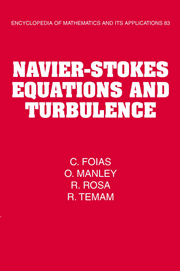Crossref Citations
This Book has been
cited by the following publications. This list is generated based on data provided by Crossref.
Temam, Roger
2001.
Stochastic Climate Models.
p.
117.
Zhaoshun, Zhang
Guixiang, Cui
and
Chunxiao, Xu
2002.
Modern turbulence and new challenges.
Acta Mechanica Sinica,
Vol. 18,
Issue. 4,
p.
309.
Doering, Charles R.
and
Gibbon, J.D.
2002.
Bounds on moments of the energy spectrum for weak solutions of the three-dimensional Navier–Stokes equations.
Physica D: Nonlinear Phenomena,
Vol. 165,
Issue. 3-4,
p.
163.
Rosa, Ricardo M. S.
2002.
Some results on the Navier-Stokes equations in connection with the statistical theory of stationary turbulence.
Applications of Mathematics,
Vol. 47,
Issue. 6,
p.
485.
Xiao, MingQing
Novy, Michael
Myatt, James
and
Banda, Siva
2002.
A Rotary Control of the Circular Cylinder Wake: An Analytic Approach.
Yang, Tianliang
McDonough, J. M.
and
Jacob, J. D.
2003.
Two-Dimensional "Poor Man's Navier-Stokes Equation" Model of Turbulent Flows.
AIAA Journal,
Vol. 41,
Issue. 9,
p.
1690.
Xiao, Mingqing
Lin, Yuan
Camphouse, R. Chris
Myatt, James
and
Banda, Siva
2003.
Numerical Simulations and Control of the Flow Past a Circular Cylinder.
Rapoport, Diego L.
2003.
Random symplectic geometry and the realizations of the random representations of the Navier-Stokes equations by ordinary differential equations.
Random Operators and Stochastic Equations,
Vol. 11,
Issue. 4,
Kukavica, Igor
2003.
On local uniqueness of weak solutions of the Navier–Stokes system with bounded initial data.
Journal of Differential Equations,
Vol. 194,
Issue. 1,
p.
39.
Hoffman, Johan
and
Johnson, Claes
2004.
Numerical Mathematics and Advanced Applications.
p.
430.
Rapoport, Diego L.
2004.
Instabilities and Nonequilibrium Structures VII & VIII.
Vol. 8,
Issue. ,
p.
313.
Wang, Xiaoming
2004.
Infinite Prandtl number limit of Rayleigh‐Bénard convection.
Communications on Pure and Applied Mathematics,
Vol. 57,
Issue. 10,
p.
1265.
Bathe, Klaus‐Jürgen
and
Zhang, Hou
2004.
Finite element developments for general fluid flows with structural interactions.
International Journal for Numerical Methods in Engineering,
Vol. 60,
Issue. 1,
p.
213.
Gibbon, J. D.
and
Doering, Charles R.
2005.
Intermittency and Regularity Issues in 3D Navier-Stokes Turbulence.
Archive for Rational Mechanics and Analysis,
Vol. 177,
Issue. 1,
p.
115.
Mucha, Piotr Bogusław
and
Sadowski, Witold
2005.
Long time behaviour of a flow in infinite pipe conforming to slip boundary conditions.
Mathematical Methods in the Applied Sciences,
Vol. 28,
Issue. 15,
p.
1867.
Rodrigues, S.S.
2005.
Controllability Issues for the Navier-Stokes Equation on a Rectangle..
p.
2083.
OBERAI, A. A.
and
WANDERER, J.
2005.
Variational formulation of the Germano identity for the Navier–Stokes equations.
Journal of Turbulence,
Vol. 6,
Issue. ,
p.
N7.
Foias, C.
Jolly, M. S.
and
Manley, O.P.
2005.
Kraichnan Turbulence via Finite Time Averages.
Communications in Mathematical Physics,
Vol. 255,
Issue. 2,
p.
329.
Cheskidov, Alexey
Holm, Darryl D.
Olson, Eric
and
Titi, Edriss S.
2005.
On a Leray–α model of turbulence.
Proceedings of the Royal Society A: Mathematical, Physical and Engineering Sciences,
Vol. 461,
Issue. 2055,
p.
629.
Chen, Zhi-Min
and
Price, W.G.
2005.
Onset of Chaotic Kolmogorov Flows Resulting from Interacting Oscillatory Modes.
Communications in Mathematical Physics,
Vol. 256,
Issue. 3,
p.
737.





